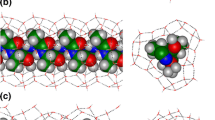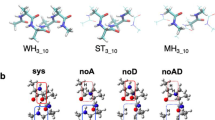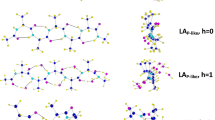Abstract
Formation probabilities of different hydrogen bonds between carbonyl oxygen and amide hydrogen were determined by Monte Carlo simulations using a computer model in the space of sterically allowable conformations of alanine and glycine oligopeptides, and the corresponding entropy losses for the peptide backbone, TΔS, were calculated. The model was studied at different criteria of steric interactions. Comparison with the data of other authors showed the values of TΔSto be mainly determined by overall extent and type of the state space and to be only slightly dependent on its energy profile. Both short-range and long-range steric interactions were shown to prevent hydrogen bonding, especially in alanine peptides. In the model studied, the initiation of α(R)-helices is associated with TΔS= 8–10 kT, and prior formation of a 3/10-turn or one three-center H-bond does not appreciably decrease this entropy barrier. Elongation of the α(R)-helix by one residue leads to TΔS= 3.0–3.7 kT, the helices begin to stabilize after at least three sequential H-bonds are formed. The difference in the probability of insertion of Ala and Gly into the helix is lower than it follows from comparison of their mobility. The results could be explained assuming that factors different from helical H-bonds take part in the stabilization of the helices. One may suppose upon modeling of folding that even three sequential H-bonds are unable to fix the structure of a flexible peptide loop, while the elongation of α(R)-helices in the supersecondary helix-loop-helix structure is favorable as long as the loop conformation remains nearly optimal.
Similar content being viewed by others
References
Brady, G.P. and Sharp, K.A., Curr. Opin. Struct. Biol., 1997, vol. 7, pp. 215–221.
Lazaridis, T., Archontis, G., and Karplus, M., Adv. Protein Chem., 1995, vol. 47, pp. 237–297.
Privalov, P.L. and Makhatadze, G.I., Adv. Protein Chem., 1995, vol. 47, pp. 307–418.
Myers, J.K. and Pace, C.N., Biophys. J., 1996, vol. 71, pp. 2033–2039.
Yang, A.-S. and Honig, B., J. Mol. Biol., 1995, vol. 252, pp. 351–365.
Yang, A.-S., Hitz, B., and Honig, B., J. Mol. Biol., 1996, vol. 259, pp. 873–882.
Sippl, M.J., J. Mol. Biol., 1996, vol. 260, pp. 644–648.
Honig, B. and Yang, A.-S., Adv. Protein Chem., 1995, vol. 46, pp. 27–58.
Stickle, D.F., Presta, L.G., Dill, K.A., and Rose, G.D., J. Mol. Biol., 1992, vol. 226, pp. 1143–1159.
Taylor, J.W., Greenfield, N.J., Wu, B., and Privalov, P.L., J. Mol. Biol., 1999, vol. 291, pp. 965–976.
Thomas, D.J., J. Mol. Biol., 1990, vol. 216, pp. 459–465.
Grigor'ev, I.V., Derevyanko, S.V., Rakhmaninova, A.B., and Mironov, A.A., Mol. Biol., 1997, vol. 31, pp. 911–916.
Grigor'ev, I.V., Mironov, A.A., and Rakhmaninova, A.B., Mol. Biol., 1999, vol. 33, 206–214.
Schultz, G.E. and Schirmer, R.H., Principles of Protein Structure, Mannheim: Springer, 1979.
Kabsch, W. and Sander, C., Biopolymers, 1983, vol. 22, pp. 2577–2637.
The Cambridge structural database (CSD). http: //www.ccdc.cam.ac.uk/support/csd_doc/volume1/ zlc07076.html.
Sung, S.-S., Biophys. J., 1994, vol. 66, pp. 1796–1803.
Doig, A.J., MacArthur, M.W., Stapley, B.J., and Thornton, J.M., Protein Sci., 1997, vol. 6, pp. 147–155.
Wang, J. and Purisima, E.O., J. Am. Chem. Soc., 1996, vol. 118, pp. 995–1001.
D'Aquino, Gomez, J., Hilser, V.J., Lee, K.H., Amzel, L.M., and Freire, E., Proteins, 1996, vol. 25, pp. 143–156.
Pal, D. and Chakrabati, P., Proteins, 1999, vol. 36, pp. 332–339.
Luo, P. and Baldwin, R.L., Proc. Natl. Acad. Sci. USA, 1999, vol. 96, pp. 4930–4935.
Avbelj, F., J. Mol. Biol., 2000, vol. 300, pp. 1335–1359.
Author information
Authors and Affiliations
Rights and permissions
About this article
Cite this article
Rakhmaninova, A.B., Mironov, A.A. Entropy Change for Free Polypeptide Chain upon Hydrogen Bonding. Molecular Biology 35, 382–391 (2001). https://doi.org/10.1023/A:1010426812725
Issue Date:
DOI: https://doi.org/10.1023/A:1010426812725




